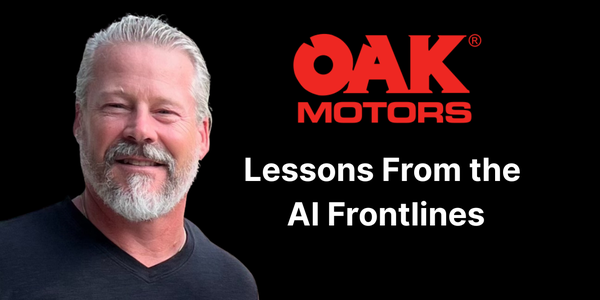5 Steps to Digital Marketing Domination

Digital marketing is a relative infant in the world of automotive advertising. Getting the word out to customers about auto dealerships was so much simpler in the early days of the industry — and it stayed that way for the better part of a century. At first, dealership advertising consisted of little more than signs, billboards, and newspapers.
Twentieth century technology soon brought radio and television, new advertising mediums that were ideal for advertising dealerships, but it’s easy to forget that commercial radio is still less than 100 years old, and TVs didn’t become household items until the 1950s. After that, dealership advertising was fairly static.
The terminology may have evolved — at some point, advertising became viewed as a subset of marketing, a broader, more wide-reaching strategy — but mostly, dealers got the message out about their brand, store, prices, and deals to potential buyers via the same methods they had for decades.
The internet changed everything starting in the mid-’90s, but even then, the shift from basic advertising via rudimentary dealership websites has mostly occurred in the past 10 years. The business of selling new vehicles, while not immune from the e-commerce world, didn’t take to it as quickly as smaller consumer goods.
But in the past decade, technological advances in advertising and marketing accelerated with the advent of social media, consumers shifting away from traditional media and desktop computers to smartphones and other mobile devices, not to mention advanced tools like artificial intelligence, data analytics, and more.
Now, a dealership that merely runs ads seems quaint, and even the terms “marketing” and “internet marketing” feel vague, like relics of the past. Meanwhile, the traditional mediums — newspaper, radio, and television — are rapidly transitioning to mobile, streaming, and on-demand models.
Digital isn’t everything — yet. But it’s close. The shift from traditional advertising to today’s multidimensional digital marketing techniques has been a sea change for auto dealerships. Some are further along on the journey than others, but given how fast technology moves, it doesn’t take that long to catch up — or fall behind — when it comes to digital marketing.
To find out from industry experts how today’s dealers can not only get a handle on digital marketing, but truly dominate with it, we asked three of our 2017 Acceleration Awards–winning companies — AutoLeadStar, Digital Air Strike, and ELEAD1ONE — to give their best five-step digital marketing primer for dealerships.
PARTICIPANTS
As CEO and co-founder of AutoLeadStar, Aharon Horwitz is passionate about bringing cutting-edge technology solutions to the forward-thinking dealership. He leads a team committed to increasing dealership sales through improved efficiency, scalability, and personalized customer experience. He regularly speaks and writes about automotive innovation, contributing to industry publications including Dealer Marketing Magazine and Dealer Magazine. A long-time entrepreneur, Aharon’s drive for developing useful technology with tangible results has garnered coverage by Inc. magazine, The Next Web, Lifehacker, MailChimp, Infusionsoft, and major automotive publications.

Alexi Venneri is co-founder and CEO of Digital Air Strike, the award-winning social media and digital engagement company. Previously, she was president of Auto Media/Blue Flame 6 and a vice president at Dealertrack, as well as the thirteenth employee at Who’s Calling, taking it from $200,000 to $70 million in just four years as chief marketing officer. An accomplished public speaker and best-selling author, she was named a Top 100 Leading Women in the North American Auto Industry for 2015 by Automotive News.

Bill Wittenmyer is partner at ELEAD1ONE. With more than 20 years experience in automotive, he oversees multiple divisions within the ELEAD1ONE organization, including sales, marketing, OEM relationships, and large client accounts. Highly regarded for his nontraditional views, he is an active speaker at industry forums and provides news commentary that reaches industry leaders.
Step 1:
It starts offline.
Horwitz: There’s a lot of work to be done before actually deploying a digital marketing strategy. You first need to identify what your dealership stands for, its core values, and its customer personas. What makes you unique among the dealerships in your area? Why should someone buy a car from you, and not your neighbor? What makes your customers tick? Once you answer these questions, you’re ready to begin marketing. Your long-term strategy will focus on building brand awareness and driving the right people to your website and eventually your showroom. Without first determining who those people are and what you stand for as a business, you are bound to spend valuable resources on irrelevant and ineffective marketing.
Be consistent. Get rewarded.
Venneri: Everything about your business online impacts how you show up on the most used search engine: Google. There are 325+ directory listing sites, review sites, and social media sites where your business information should be accurate — while also knowing all the sites to add content — to set you apart from your competition. Make sure the information is the same across all sites. This consistency will be rewarded, and will help you show up higher in Google search results. Google also shows your reviews from around the web, meaning your star ratings on Facebook, Cars.com, and many others will be listed in side page search results for your business. With the new Google My Business feature, you can showcase your top reviews, survey comments, and dealership specials with custom content and even a visual graphic “tile,” which ultimately looks like Google itself is highlighting your review or great deal. Work with a partner that knows how to showcase you in this way, [as well as the rules about] how some content needs to be reloaded and refreshed every seven days.
Align strategic goals to business model.
Wittenmyer: The first step is to understand the dealership business model, review current performance, and develop strategic plans for each target area. The model centers on the primary profit centers, sales and service. Within each department, there are two types of customers that can transact: retention customers who have previously done business with that department, or acquisition customers who are first-time buyers. Each group represents a future opportunity for another sale or a referral. On paper, [this business model] would appear as a square with customers funneling from acquisition to retention stages and from department to department, throughout the journey of the vehicle ownership life cycle. Evaluating the performance of each segment gives an understanding of how each is performing financially and operationally. This analysis can also help pinpoint the traffic volume required to meet sales and service objectives. Targeted understanding of each customer type allows the dealer to define the objective of each segment, and begin building a strategic strategy.
Step 2:
Target, don’t spray
Horwitz: Once you have identified your audience, you need to reach them. While strong SEO strategies and quality content will help customers find you before others in your area, they are often not enough to reach your audience. Utilizing PPC [pay-per-click] campaigns on platforms like Google and Facebook significantly increases your reach. Don’t stop there, though.
To get the most out of PPC, go beyond simple ad buying and retargeting. Use “data onboarding” of your existing CRM lists to build “lookalike audiences,” as well as unique target groups.
For example, you can target those people whose lease is up for renewal in the next 60 days. Be sophisticated in how you bucket new site visitors: what reveals a service customer, what reveals a customer further down the funnel, etc. Target accordingly–there is no single ad or strategy that will speak to every type of customer.
Get advertising insurance
Venneri: When someone sees or hears your ad on TV or radio, or even sees your ad on social media, chances are they will Google your business — even if only to find out your location, hours, or web address. As I mentioned earlier, your star ratings from around the web will show up in that search.
So, imagine — no matter how slick your ad is or great your specials are — having to compete with a two-star rating, or even a five-star from only one review. And everyone with an iPhone that uses the built-in map feature automatically sees your Yelp star rating along with your location.
Having a good online reputation is insurance for every ad dollar you spend. Improving your reputation is as easy as surveying your customers and encouraging the happy ones to post their feedback on top review sites. You can even get more immediate response by sending happy customers a text message asking them to share their experience at your dealership on top review sites.
Segment: Direct action vs. branding
Wittenmyer: Next, identify how much of the marketing budget will be allocated to digital branding versus direct action. Digital branding includes larger marketing budgets, targeting large and initially unknown audiences, including SEM campaigns, display ads, retargeting campaigns, inventory syndication, and social media. These methods are geared toward reaching a large audience and identifying individual prospects, targeting consumers at various life cycle stages.
They cast a wide net for audiences with similar traits to customers, users searching by keyword, or vehicle hunters. Modern technology enables dealers to present multiple ads around the web after an initial visit to the store website. Direct action is like throwing a dart. You know exactly who the individual is and the specific message needed.
These marketing campaigns typically originate from triggered events, business intelligence, or online/offline behavior. These known opportunities need one-to-one digital messaging and targeted email campaigns. To boost response rates and maximize, savvy dealers pair digital strategy with opt-in text messages, live phone follow-ups, or targeted direct mail pieces to deliver a multi-channel message.
Step 3:
Differentiate your website
Horwitz: Website abandonment is the single biggest problem in your funnel. With 67% of shoppers only visiting one to two dealerships in person, your website might be their only impression of you. Dealership websites tend to look similar to one another. Yours should stand out by the strength of its offers, image quality, content, and third-party vendor tools.
Since they are a big part of your digital marketing strategy, it’s important to make a note on third-party tools like chat, pop-ups, trade-in, and credit prequalification — they need to be as optimized as the rest of your site, both on desktop and, just as importantly, mobile. Avoid heavy iFrames [inline frames] and synchronously loading JavaScript codes that slow down your site’s speed. Steer clear of Google “no-no’s” and third-party tools that open in new tabs, driving traffic away from your site. A helpful and seamless online experience will compel shoppers to convert.
Rethink what a lead is
Venneri: Social media is now a place where consumers feel comfortable communicating directly with businesses, asking questions about everything from scheduling a service appointment to price of a vehicle. Every comment on a post or ad needs to be addressed. Think of this communication as a lead, as people are using social media to research dealerships and vehicles before they even walk onto your lot.
New features such as Facebook Marketplace literally turn social networks into marketplaces where they [can] even message and negotiate car sales. Even if the communication doesn’t lead to a sale or service appointment, the interaction will show your audience that you’re paying attention and customer service is important to you.
Have a plan and dedicated response times set with your internal team or social media vendor to ensure that the right and timely responses occur just like you would for email, web, or phone leads. It is crucially important as other prospects see your interactions and responses, unlike other mediums. It can be just as or even more lucrative to make sure that you have these expectations in place, and you inspect what you expect.
Market to the VIN
Wittenmyer: Stop marketing to the customer! While this sounds counterintuitive initially, understanding why the marketing strategy exists is crucial to capturing profitable service and future retention opportunities. A customer has never spent a dollar at the dealership for anything but a vehicle, so tailoring messages for specific vehicles and delivering supporting messages to customers is key.
Successful dealers design a marketing strategy based on a commodity marketplace that focuses on the inventory available for sale, and promotes the vehicles that have potential for service revenue. For greater profitability, traffic-generating efforts should be centered on models requiring faster turns, scaling up the volume to meet sales objectives.
For the service department, dealers must ensure each message is relevant. If the customer no longer owns that vehicle and the new owner lives in the market, dealers should pivot to the conquest of the new owner. After focusing on the vehicle, determine the appropriate message for that customer that will generate the greatest interest.
Step 4:
Win the conversion battle
Horwitz: Speaking of conversion, isn’t that the point of all of this? Don’t think of any conversion point on your website as a final destination. Encourage users to convert more than once, by offering a test drive appointment after converting on an offer, for example. Bring them to the showroom with as rich a CRM file as possible, and with them highly motivated.
I really encourage dealers to invest in an artificial intelligence–based platform for conversion optimization. There are so many ways to optimize a user’s experience that you need the advantages that modern machine learning can provide. For example, tools like Falcon by AutoLeadStar will show content and engagements — like a trade-in or test drive form, e-price, reviews, etc. — to a visitor based on hundreds of unique parameters that it studies in real time. Better conversion rates mean that every dollar you spend creates sales more efficiently.
Immediate response required
Venneri: We recently mystery-shopped more than 1,500 dealerships and found only 16% of [them] responded in less than 15 minutes. Another study shows internet shoppers who receive a response within 10 minutes are three times more likely to visit the dealership. So basically, not only will a quick, detailed response win customers — it will make it easy for you to beat your competition.
Today’s consumers are online at all hours shopping, and expect a response almost immediately no matter the time of day. Make sure your dealership is prepared with the staff or the tools to respond quickly to internet leads, and provide the detailed information the customers are requesting. Your response should include price quotes for several vehicles, not just the one requested. Include new and used options as well as the ability to calculate the payment. Most shoppers will buy the car they can afford — not necessarily the one they first asked about.
Multiple touch points
Wittenmyer: The marketing strategy needs unifying messaging and outreach via a variety of communication platforms for the dealership business model, and segmentation of the two different customer types. The consistency of the message is important. Most consumers require six to 12 marketing touches to convert into a viable lead.
It is certainly acceptable for dealers to have multiple partners working on different aspects of a single campaign strategy, but this requires partners that value cooperation and dealership success. Experienced partners with a track record of organization and follow-through must coordinate such strategies carefully. Ultimately, the goal is to consistently deliver the touches required to convert a customer across a variety of channels.
Step 5:
Test, test, test!
Horwitz: You can’t simply “establish” a digital marketing strategy — what worked months ago may not work now, and newly released tools could improve your numbers. Your dealership needs to constantly track results and new products. A/B testing can be tedious, but without trying out a variety of methods and strategies, there is no way to determine if you could be doing even better.
When considering vendors, be sure to ask how they track success and what types of analytics you can expect to receive. Regularly calculate the ROI of all of your existing tools, and ask vendors whenever anything is unclear. As part of your calculations, you should look at costs, whether the results match your expectations and goals, and if there are other tools that could do even better. With frequent assessment and innovation, your dealership is on its way to reaching more people and converting browsers into buyers.
Social ads: A targeted approach
Venneri: The days of blasting a high-dollar ad to the masses are quickly dying. Social media advertising has really revolutionized the industry by allowing businesses to target their advertising to people actively interested in their products. No longer should you just set a big ad buy budget — you just don’t need it. The approach is more crucial and strategic.
Try targeting ads in a one-to-one format, such as serving up ads to service customers that are in equity for the newer model than what they just came in for. Facebook, for one, is constantly learning from its users. Every click [and] every pause turns into a profile that Facebook provides to advertisers. Not only does this make advertising more cost effective than it’s ever been, it also makes the ad experience less intrusive for the customer, as your ads will only appear in front of people looking to buy or lease a new car.
All of these benefits come at a fraction of what most dealers spend on traditional advertising — even including their Google PPC budget — and can generate incredible results.
Measuring ROI
Wittenmyer: Fortunately, measuring ROI is now easier than ever before. By aligning digital and direct marketing strategies with the dealership business model, the impact of each channel directly influences the overall operational and financial results. The dealership can review how effective each strategy is at driving incremental customers to the showroom or the service drive.
To measure successfully, dealers must break down each campaign to determine the sales or service objectives, and also factor in the value of new customers versus repeat business. Reviewing ROI and performance in this manner creates a high level of accountability and ensures accurate decisions are made for future campaigns. Too often, dealerships fall into the trap of making sweeping marketing changes and forget the importance of targeting the vehicle. With appropriate targeting, relevant messages for each audience, and clear expectations of the business objective for every campaign, dealerships are prepared to dominate their local markets.
Tags:
authored by
Kurt Stephan
Get Curated Insights
Content worth the click
Related Articles













